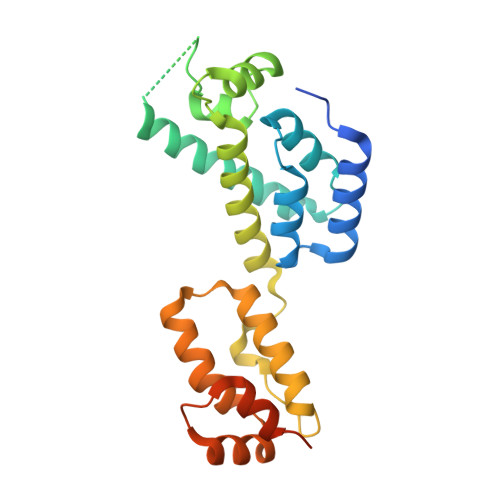Structural insights into HIV-1 polyanion-dependent capsid lattice formation revealed by single particle cryo-EM.
Highland, C.M., Tan, A., Ricana, C.L., Briggs, J.A.G., Dick, R.A.(2023) Proc Natl Acad Sci U S A 120: e2220545120-e2220545120
- PubMed: 37094124
- DOI: https://doi.org/10.1073/pnas.2220545120
- Primary Citation of Related Structures:
8G6K, 8G6L, 8G6M, 8G6N, 8G6O - PubMed Abstract:
The HIV-1 capsid houses the viral genome and interacts extensively with host cell proteins throughout the viral life cycle. It is composed of capsid protein (CA), which assembles into a conical fullerene lattice composed of roughly 200 CA hexamers and 12 CA pentamers. Previous structural analyses of individual CA hexamers and pentamers have provided valuable insight into capsid structure and function, but detailed structural information about these assemblies in the broader context of the capsid lattice is lacking. In this study, we combined cryoelectron tomography and single particle analysis (SPA) cryoelectron microscopy to determine structures of continuous regions of the capsid lattice containing both hexamers and pentamers. We also developed a method of liposome scaffold-based in vitro lattice assembly ("lattice templating") that enabled us to directly study the lattice under a wider range of conditions than has previously been possible. Using this approach, we identified a critical role for inositol hexakisphosphate in pentamer formation and determined the structure of the CA lattice bound to the capsid-targeting antiretroviral drug GS-6207 (lenacapavir). Our work reveals key structural details of the mature HIV-1 CA lattice and establishes the combination of lattice templating and SPA as a robust strategy for studying retroviral capsid structure and capsid interactions with host proteins and antiviral compounds.
Organizational Affiliation:
Department of Molecular Biology and Genetics, Cornell University, Ithaca, NY 14853.














